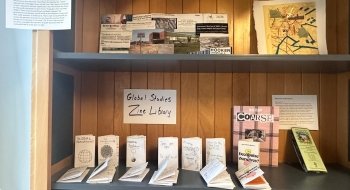
St. Lawrence’s Diversity and Inclusion Coalition Designed to Weather Any Storm
This is a moment in time, now, that is, once again, bringing to light some of the challenges that we've been facing for generations. The disparities have existed for a very, very long time. They didn’t appear with COVID-19, but the disease brought them to light, along with tragic and deadly consequences of police brutality and racial violence. This is not new, but it is still a difficult moment.”
Last summer, in mid-August, northern California experienced 12,000 dry lightning strikes in one week, sparking hundreds of wildfires across the state with 1 million acres lost in a matter of days. California was not alone: 13 Western states had uncontained fires by the end of that month, and the rest of the country had been pummeled by the likes of Bertha, Kyle, Vicky, and Wilfred—more than 30 back-to-back tropical storms and hurricanes, as well as unusual tornadoes and extreme flooding, including here in northern New York.
In any other year, 12,000 dry lightning strikes and 1 million acres lost would have been the cataclysmic event of the decade, but in 2020, it was just another boulder in the avalanche of disasters that battered the nation.
Add the battle against COVID-19 to the list of challenges in 2020. The global pandemic exhausted communities and institutions and sent businesses, large and small, into economic free fall, charting inversely to the spike in infection rate and the tragic death toll of hundreds of thousands in the United States alone.
But that was not all the politically polarized, general election year of 2020 had in store. Protests for racial justice gripped the U.S. with a backdrop of the disproportionate toll that COVID-19 was taking on communities of color and a litany of murders and violence inflicted on Black and Brown men and women—George Floyd, Breonna Taylor, Ahmaud Arbery, and Jacob Blake to name some of many—confirming the life and death consequences of racial inequities and systemic failures of public health and public safety systems in America.

“This is a moment in time, now,” says Kimberly Flint-Hamilton, associate dean for Diversity and Inclusion at St. Lawrence University, “that is, once again, bringing to light some of the challenges that we’ve been facing for generations. The disparities have existed for a very, very long time. They didn’t appear with COVID-19, but the disease brought them to light, along with tragic and deadly consequences of police brutality and racial violence.” She continues, “This is not new, but it is still a difficult moment,” and “difficult,” she emphasizes, “is an understatement.”
For Flint-Hamilton, and her faculty, staff, students, and alumni partners, the only silver lining to this upheaval is that the inequities and injustices that people from underrepresented identity groups have suffered are being recognized with a renewed sense of gravity and urgency that is long overdue. It is an urgency that can help inform the campus conversation on race and racism right here in the North Country.
“This presents us with an opportunity,” she says, “to work toward creating a more just, more equitable, and more inclusive society, and certainly a more just, equitable, inclusive St. Lawrence. I think that we can achieve that,” she says. “I don’t think it will happen overnight, but I think that is achievable.”
The caveat, however, according to Flint-Hamilton, is that “it’s going to require that we go through a period of pain. We’re going to have to have difficult discussions and really look squarely at practices, policies, and attitudes that have either inadvertently or implicitly fostered an exclusive and sometimes harmful and hurtful culture.”
For Flint-Hamilton and her partners across campus, once again, it is time to ask the hard questions, questions such as: how can we take ownership of our failures in inclusivity and convert them into a positive, albeit possibly painful, path to progress? What does truth and reconciliation look like at St. Lawrence? And, how do we live up to our Laurentian values?
“We are definitely at a crossroads,” says Flint-Hamilton, who, with an array of career Laurentians on the University Diversity Committee, is keenly aware that Laurentians of every generation have a different lens on the road ahead and reconciling what defines moving forward is also part of what makes the effort so complex.
The Goal is Simple: Strategic Action Plan for Diversity and Inclusion
Informed by the institution’s 2014 “Presidential Commission on Diversity Report,” the 2018 “Campus Climate Survey for Diversity and Inclusion,” as well as from focus groups conducted throughout the 2019-2020 academic year in partnership with Christine Zimmerman, director of Institutional Research, Flint-Hamilton insists that “this plan is a living document.”
Both Zimmerman and Flint-Hamilton want people to be realistic and understand the internal and external factors that may inform or interfere with progress. Despite the complexities, the goal is simple: “to become a community that is diverse, equitable, and inclusive, a community in which all members can flourish.”
The action plan is organized around five themes tied directly to the University Diversity Statement with short, intermediate, and long-term initiatives outlined for each:
- Cultivate an inclusive community university-wide.
- Expand the diversity of our community with bold recruitment efforts.
- Foster a campus culture of inclusion by improving retention.
- Infuse diversity and inclusion throughout the curricular and cocurricular programs.
- Connect community member across different social identities.
“We need to be nimble and flexible,” Flint-Hamilton says, “because a year from now, two years from now, things may change, or because our perspectives are limited to what we could see today, we left something off that really needs to be included in the future. We need to make sure that we’re including as many voices as we can.”
“The bottom line,” she says “is that we need to be open to constructive criticism and look for opportunities to always work with others.” She points out that at St. Lawrence, there is no shortage of individuals and groups invested in this goal.
The Black Laurentian Initiative
A new group adding their voices to the racial equity work at St. Lawrence is The Black Laurentian Initiative (BLI), a grassroots student organization that formed in the wake of the violence against and murders of Black Americans in 2020. BLI President Hamidou Sylla ’21 recalls the graphic videos of the Minneapolis police officer kneeling on George Floyd’s neck and the disturbing footage of the murder of Ahmaud Arbery in the suburban streets of Georgia.
“Students of color were feeling the full weight of watching ourselves being murdered on camera,” says Sylla. “Regardless of what was going on in the outside world, we were looking to our institution to say something, do something, and stand up for us.” Although the University sent an email to the campus in solidarity, to many students, it wasn’t enough. Sylla confesses, “Some saw it as empty rhetoric and wanted more.”
Despite the feeling that the University’s message fell short, Sylla says the response from President William L. Fox ’75 and members of the University community to fund and support new initiatives has been encouraging and has served as a catalyst for Black students and their student allies across campus to organize in a different way and coordinate a constructive dialogue with the University. Michael Paulino ’20, one of the co-founders of BLI, is also eager to explore how students can become a part of reimagining and reinvigorating interdisciplinary anti-racism strategies at St. Lawrence.
“The limitations that plagued many examples of student-led activism here at St. Lawrence is that, historically, they have been siloed to specific individuals or clubs working independently, without much cohesion,” says Paulino. “The thing that makes what Hammi did special, what makes BLI special, is that we were able to unite people like Joshua Morrison ’21, Hana Bushara ’21, Ramon Veras ’21, and many others who have been fighting this fight for years into a movement that is dedicated toward shaping a brighter, more inclusive future for Laurentians in the generations to come.”
We have partnered with many groups of professors on how to identify racist structures in our curriculum and navigate them in ways that will successfully dismantle them, so the BIPOC experiences are taught more authentically and comprehensively.”
Barlin Osman ’22, vice president of the Black Laurentian Initiative
“Our primary focus is to address anti-Blackness at St. Lawrence University and analyze the strengths and weaknesses of our University’s scholarly, cocurricular, administrative, and other efforts to be actively anti-racist,” adds Sylla. “And, secondly, to address issues that not only impact the black community, but the BIPOC (Black, Indigenous, and People of Color) community in general.”
“We have partnered with many groups of professors on how to identify racist structures in our curriculum and navigate them in ways that will successfully dismantle them,” says Barlin Osman ’22, BLI’s vice president, “so the BIPOC experiences are taught more authentically and comprehensively.” Osman notes, however, that although the faculty whom they are working with already come from multiple disciplines, BLI hopes to expand involvement to all disciplines and departments without exception.
One outcome of this partnership has been the developments of a new BLI Grant program to fund research initiatives and internships that are associated with anti-racism education, with an emphasis on multidisciplinary approaches. “The recipients of this grant will be asked to bring any findings and new knowledge back to the St. Lawrence community in a variety of ways,” Osman adds, “so we all can benefit from their research and experience collectively.”
“This is really what change looks like,” believes Sylla, who, like every Laurentian, wants St. Lawrence to lead the way and is excited by the willingness of sophomores and juniors to take the helm moving forward. “As the saying goes, we are all ‘Laurentians for Life,’” says Sylla. “We want to have that pride, knowing the rest of the world is looking at St. Lawrence students, and thinking, ‘We want to follow in their footsteps.’”
For Flint-Hamilton, the Black Laurentian Initiative is an exciting development because they are part of a multidimensional, multi-aspirational, and multigenerational coalition to propel progress and build in accountability.
“The next step is connecting the pieces and to continue to have conversations, to make sure that we’re working together and in alignment,” Flint-Hamilton says. She recognizes that, although BLI and other student groups may articulate their strategies differently, this doesn’t mean that their efforts are in conflict. In fact, she believes the work across campus is complementary.
Laying the Groundwork
The reimagining of the strategic plan and ideas from faculty, staff, and student groups like the BLI are not new, but the energy behind them are a welcome addition to much of the work in progress. There have been generations of faculty, staff, students, and alumni who have influenced, in some capacity, ways to move the needle at St. Lawrence.
Over the past 20 years, efforts to recruit and retain a more diverse population have made progress. From 1999 to 2019, the number of U.S. students of color has grown from 6 percent to 12.7 percent, international students from 3 percent to 9.5 percent, and faculty of color from 6.9 percent to 16.3 percent. St. Lawrence administrators and trustees are the first to recognize that although these efforts have spurred positive outcomes, the burden of building community is often most taxing on the small population of faculty, students, and staff of underrepresented groups on campus, and there is much more work to be done to fulfill the vision expressed in the St. Lawrence Statement of Diversity.
Other efforts over the past several decades have gotten significantly more traction, especially in the area of curricular developments and building an understanding of and commitment to diversity, inclusion, and equity.
In the 1990s, the campus secured a Cultural Encounters grant as well as Christian Johnson Endeavor Foundation funding to create a new curriculum that emphasized the positionality of cultures and communities being studied and interculturalism within the United States. The design of the global studies major, for example, was an outcome of the Christian Johnson Endeavor Foundation funding. A Ford Foundation Crossing Borders grant in the late ’90s was committed to questioning and rethinking the subject-object relations of area studies with new, more inclusive models and a Hewlett grant focused on a thorough survey of campus climate on diversity. By 2005, with a grant from the Teagle Foundation, St. Lawrence faculty members were reimagining the academic requirements and redesigning curriculum to enhance the student’s learning outcomes related to domestic and international understanding of race and culture.
The development of course offerings in African American Studies and other ethnic studies programs has helped contextualize the often underrepresented and underappreciated historical, literary, artistic, and ideological contributions of minority groups in the United States as well as chart the contemporary landscape of our racial, ethnic, and class relations. During the last decade, University leaders have made diversity a central component of major institutional initiatives, such as the Strategic Map developed in 2011, the Diversity Graduation Requirement from 2013, the Presidential Diversity Commission Report in 2014, and The Campaign for Every Laurentian, which publicly launched in 2018.
Faculty members who were involved in many of these initiatives continue to develop programming to advance the goals and recommend-ations from the 2014 Presidential Commission. Mary Jane Smith, associate professor of history and coordinator of African American Studies, director of the Mellon Foundation Sophomore Journeys Grant, and member of the University Diversity Committee, has spent the last five years expanding the Intergroup Dialogue (IGD) program at St. Lawrence. What began with a campus innovation grant in 2015, under the leadership of Smith and Valerie Lehr, then vice president and dean for Academic Affairs and professor of government, has now expanded to include a series of workshops, Residence Life staff trainings, a dedicated course, and the embedding of IGD principles within other classes and curriculum.
“For me, the heart of Intergroup Dialogue is having multiple interactions,” says Smith. “It is not just a one off. For example, students working as CAs (community assistants) participate in at least four or five IGD workshops within their first year, and then at least twice a year after that.” Unfortunately, COVID-19 restrictions have interfered to some extent, but the program has reached between 200 and 250 students each year and continues to refine the ways campus constituents find common ground.
Most recently, Smith and her colleagues the Elizabeth Margaret Vilas Professor of History Donna Alvah and Associate Professor of Philosophy and Coordinator of the Peace Studies Program Laura Rediehs have assisted students and faculty in navigating the contentious political climate of the 2020 general election. Workshops and virtual seminars helped equip colleagues with techniques for overcoming obstacles during conversations between opposing political viewpoints.
“We have to teach each other how not to just give up on each other when something difficult emerges,” says Rediehs. “There really are ways to work through these difficult moments, and these moments become powerful learning experiences and can forge stronger relationships as well.”
The work continues in a myriad of ways. The new Civic Dialogue Fellowship program to foster open and respectful conversations among students has been made possible through a gift from Martha MacCallum ’86. The Black Laurentian Initiative helped secure $100,000 to support student scholarly research on racial justice topics over the next two years. Campus Life and Academic Affairs continue to develop intercultural programming that expands perspectives on LGBTQ+, Native American, international, and racial justice issues as well as programs to recognize and celebrate every Laurentian on campus. Finally, Flint-Hamilton hopes to launch a diversity ambassadors program for students to continue fostering dialogue across campus constituents. Capitalizing on all of these homegrown initiatives is a testament to how an organic coalition is forming on multiple fronts.
Weathering the Storm: All Hands on Deck
Flint-Hamilton recognizes that all departments and divisions of the campus may be in different places and have unique circumstances that need a different approach. The coalition that is forming, however, has no boundaries and is open to all Laurentians.
“I’m going to ask everybody to think about where their challenges are and where they feel like they want to grow so that everybody is moving in the same direction,” she says, recognizing that some may be new to this work, while others may have decades of work already cataloged.
Other related initiatives include efforts by Trustee Sharee Freeman ’76 to recruit more alumni mentors for students of color, as well as the Inclusion, Diversity, and Equity Across Laurentians (IDEAL), a networking and mentoring effort for underrepresented populations organized through the Office of Laurentian Engagement. The Alumni Executive Council has also launched a new subcommittee focusing on diversifying the work and representation of the Alumni Council.
“The reality of diversity and inclusion work is that it is never smooth sailing. It isn’t easy, but it is always worth it,” says Flint-Hamilton. “I believe we have come face to face with all the stress and the depression and anxiety and the frustration that everyone is suffering, either just from paying attention to what’s going on in the world and in the news, but also from having lived through these turbulent times. Even our beautiful little community has been really shaken by all this,” she says, confident that, together, Laurentians can weather any storm.




